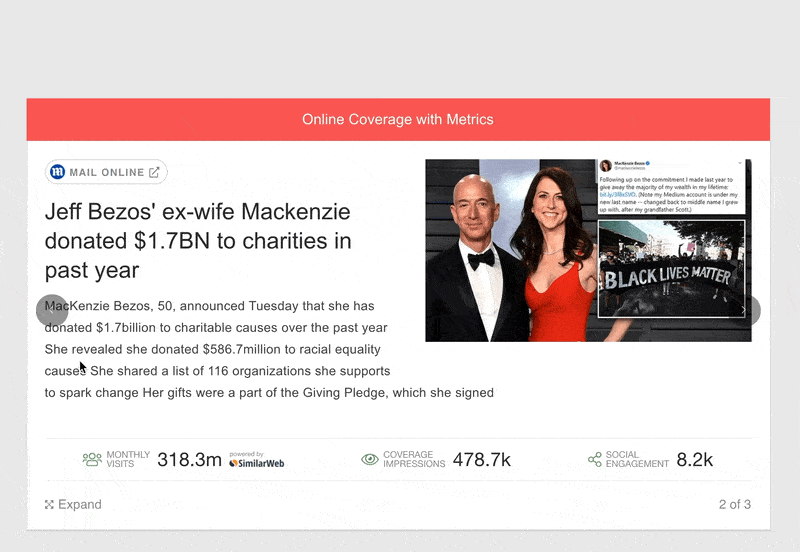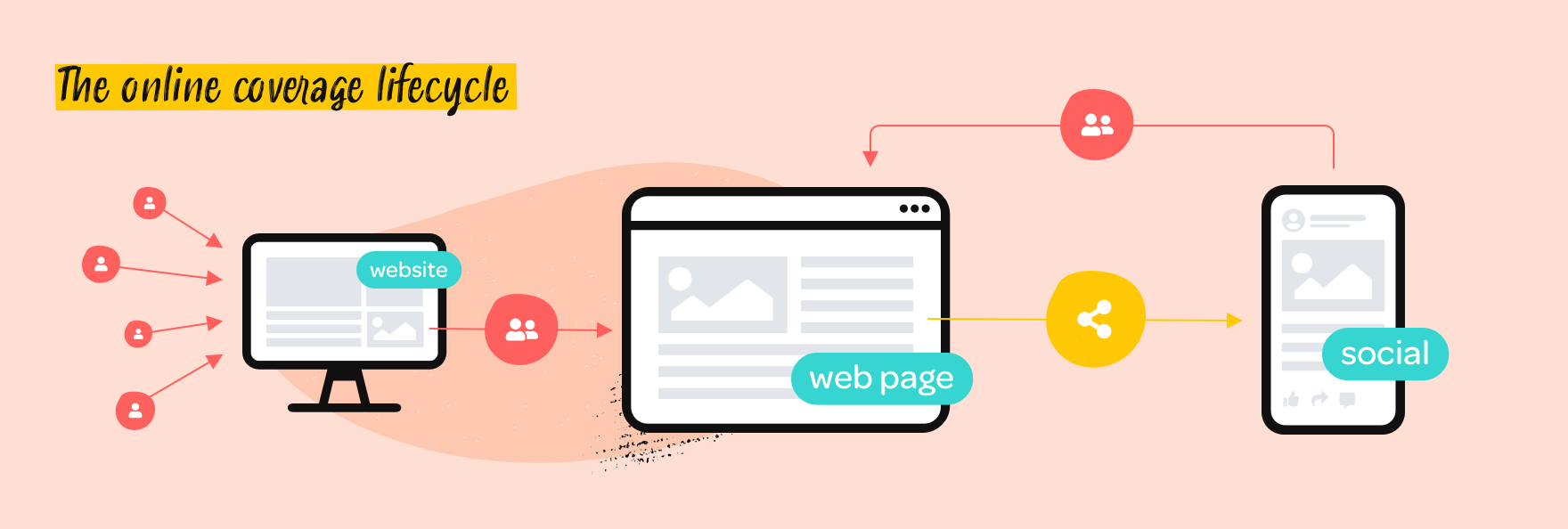A raft of automated metrics can be displayed alongside online coverage within a Releasd report.
You can find a summary of all available metrics here.
Below, we describe how these metrics are generated.
Website Visits
This is an estimate for the total number of visits that an entire website receives in a month.
Data is provided by SimilarWeb, the world’s leading source of third party website traffic data.
Coverage Views
The lifecycle of an online article often extends beyond its exposure on a website.
If shared, the story then receives attention across social media.
Some of those who view it on social will then click through to read it on the source website.
We believe that all of this valuable attention should be captured.
Coverage Views is our estimate of how many times an article will be viewed on the publishing website *and* across social media.
Coverage Views is therefore our estimate of the number of views a specific article will receive within a particular website, PLUS the number of Views it's likely to receive across social media platforms (if it's been shared), ie:
Coverage Views = Coverage Views on Website + Coverage Views on Social Media
In other words, the total number of times that a piece of coverage gets seen, anywhere.
Estimating the number of times coverage will be seen on a website
As many Comms professionals know, media outlets tend not to share web traffic data for specific articles with third parties. That means PRs are often in the dark when it comes to knowing how many people have viewed a story on any given website.
To create an algorithm that can effectively estimate this metric, Releasd partnered with SimilarWeb.
In a groundbreaking project, Releasd provided SimilarWeb with over 11,000 genuine coverage URLs (fully anonymised) and SimilarWeb returned a wealth of data, including estimated views for each individual article.
From this data and other supplementary sources, we were, for the first time, able to analyse the myriad factors that can impact an article’s share of traffic to a given website, including:
- Size of the website
- Category of the website
- Authority of the website
- Average time spent on the website
- Bounce rate of the website
- An article's location within the website
- And more
We then codified the relevant factors into a proprietary algorithm that can estimate, for any given URL, the likely number of times that the article will be seen on the publishing website.
Accounting for the popularity of a story
Let's imagine that there are two articles within the Technology section of the same website. As discussed above, we're able to estimate a baseline number of views that those articles are likely to receive over their lifetime.
However, we can see that the first story is being shared more than the second. We assume that some of those shares will result in 'referral' traffic back to the source website and take this into account in our algorithm.
That is to say, in the case above, the number of views of the first article will be higher than the second.
Coverage metrics will improve if an article is being shared across social media channels.
It also means that metrics relating to your coverage will improve if it's being shared across social channels.
Estimating the number of times coverage will be seen across social media platforms
If an article has been shared, then it's likely to be seen by the followers of the sharer. The story is now getting even more attention.
We want Marketers to receive full credit for their hard work, so we measure this social attention and feed it into our algorithm.
Views on 'open social' platforms
In order to estimate how many people will see an article on open social platforms (Facebook, Twitter and Pinterest), the first thing we need to ascertain is how many people, if any, have shared it at a given point in time.
Given that 99.8% of visitors to a web page do not use the familiar embedded social sharing icons, we need another way of fetching the data. Luckily, we can obtain this from the platforms themselves.
Facebook, Twitter and Pinterest provide live share data via their APIs. That's why they're described as 'open' social media platforms.
Now we know how many times a piece of coverage has been shared, but how can we estimate how many people will actually see it across each channel? In other words, how many 'views' is it likely to get?
For this, we partnered with GetSocial who provided us with data generated from over 26 million tracked shares in early 2020. This included the average number of referrals to a website generated by a share across each open social platform.
Now we know the number of shares and the number of referrals per share, ie the number of people who saw the article on social and clicked back to the source website.
But what about the people who saw it and didn't click through?
To calculate this, we estimated a click through rate (CTR) for organic posts published by personal accounts on social media*.
Adding the 'clickers' and 'non-clickers' together gives us an estimate of how many times the post was seen in total - in other words, our Open Social Views.
Views on dark social platforms
A 'dark' social platform is one that does not provide any data for content shares or engagement. However, research shows that they account for a vast majority of sharing activity. Copying a link and pasting it into WhatsApp, Facebook Messenger, Linkedin or the many other platforms not covered above counts as a dark social share.
Dark social media channels like WhatsApp, Facebook Messenger or Linkedin do not provide share data.
GetSocial were also uniquely placed to track these activities, and provided us with data based on 153 million dark social shares and related referrals. Crucially, it also highlighted the relationship between open shares and dark shares.
Using the same methodology as above, we can calculate estimated views for a given article across dark social media channels.
*At the time of writing, no adequate research could be found on click through rates of organic posts shared by personal social media accounts. According to global research from SmartInsights in 2020, the average CTR of a Facebook ad in the newsfeed was 1.1%. It seems safe to assume that the CTR for personal posts is higher. We have set the organic click through rate for personal social posts at 5% until such time that better data becomes available.
Social Engagement
As mentioned, open social platforms provide data relating to the number of shares and level of engagement a given article has received. We display this information and update it on a regular basis.
Dark social platforms do not provide such data directly.
We're able to estimate how much engagement an article is getting on dark social based on open social activity.
However, GetSocial's data enabled us to estimate the number of dark social shares an article is likely to receive based on known open social activity.
Note that if there have been no open social shares, then the number of estimated dark social shares will always be zero.
For a summary of all available automated metrics, click here.




